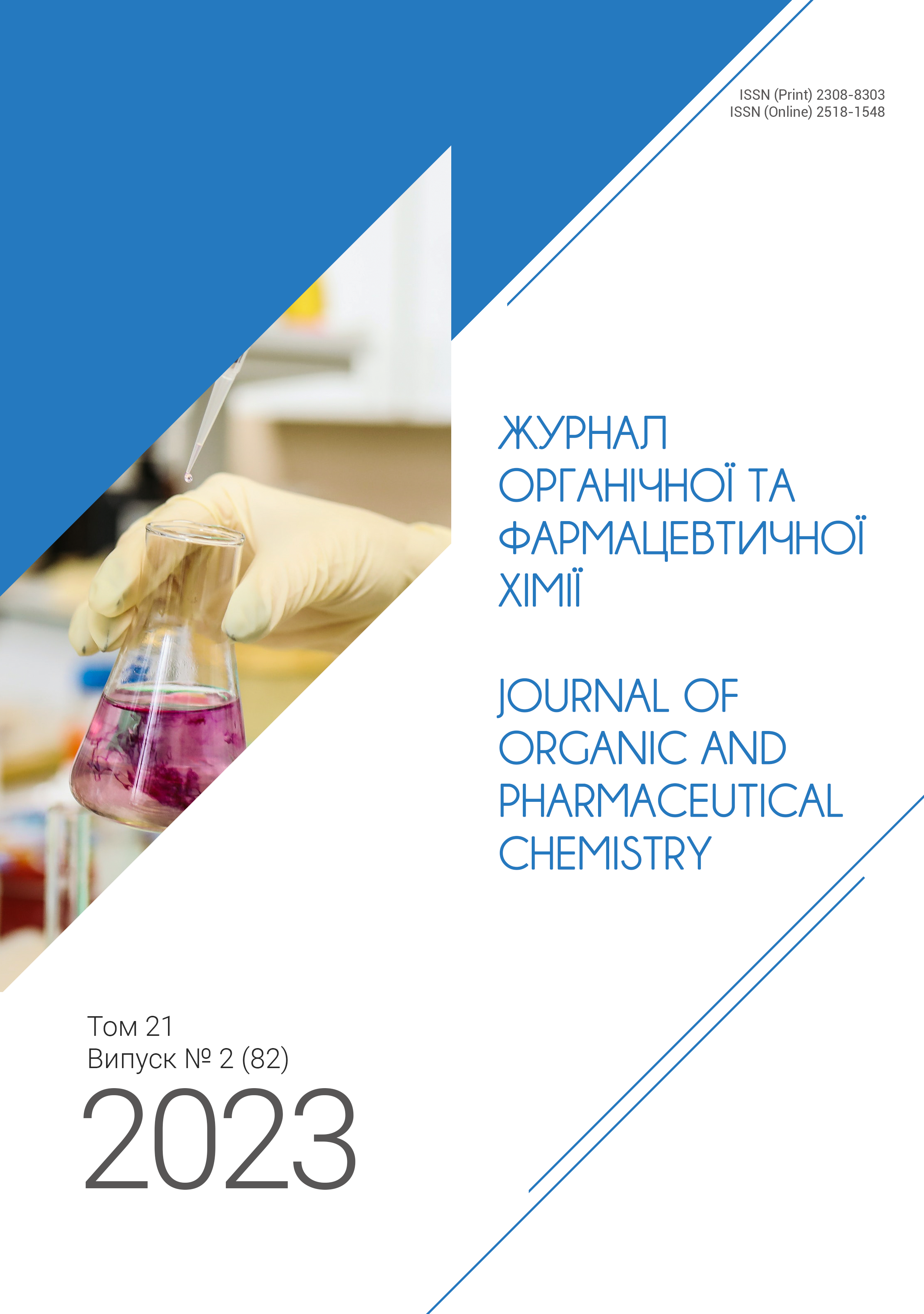The Synthesis of 1-Alkyl-3-polyfluoroalkyl- 1,3-dihydrobenzimidazole-2-selenones as Potential Plant Growth Regulators
DOI:
https://doi.org/10.24959/ophcj.23.278660Keywords:
N-polyfluoroalkylazoles, benzimidazole-2-selenones, plant growth regulationAbstract
Aim. To synthesize new 1-alkyl-3-polyfluoroalkyl-1,3-dihydrobenzimidazole-2-selenones and study their biological activity as potential plant growth regulators.
Results and discussion. 1-Alkyl-3-polyfluoroalkyl-1,3-dihydrobenzimidazole-2-selenones were obtained from the corresponding 1-alkyl-3-polyfluoroalkylbenzimidazolium iodides by the action of elemental selenium in the presence of a base. The preliminary biological tests for the growth-regulating activity of the compounds obtained were conducted.
Experimental part. The structure of the compounds synthesized was proven by 1H and 19F NMR spectroscopy methods, as well as by the elemental analysis. The biological studies were done on model plants of winter wheat of the “bezosta” variety.
Conclusions. A convenient method for obtaining 1-alkyl-3-polyfluoroalkyl-1,3-dihydro-benzimidazole-2-selenones has been developed. Biological studies have shown that the compounds synthesized have a diverse effect on the plant growth.
Supporting Agency
- The authors received no specific funding for this work
Downloads
References
- Stadtman, T. C., Selenium-Dependent Enzymes. Annu. Rev. Biochem. 1980, 49 (1), 93-110. https://doi.org/10.1146/annurev.bi.49.070180.000521.
- Sliwkowski, M. X.; Stadtman, T. C. Incorporation and distribution of selenium into thiolase from Clostridium kluyveri. Journal of biological chemistry 1985, 260 (5), 3140-3144. https://doi.org/10.1016/S0021-9258(18)89484-4.
- Saelinger, D. A.; Hoffman, J. L.; McConnell, K. P. Biosynthesis of selenobases in transfer RNA by Escherichia coli. J. Mol. Biol. 1972, 69 (1), 9-17. https://doi.org/10.1016/0022-2836(72)90020-4.
- Wittwer, A. J.; Tsai, L.; Ching, W. M.; Stadtman, T. C. Identification and synthesis of a naturally occurring selenonucleoside in bacterial tRNAs: 5-[(methylamino)methyl]-2-selenouridine. Biochemistry 1984, 23 (20), 4650-4655. https://doi.org/10.1021/bi00315a021.
- Carvalho, K. M.; Gallardo-Williams, M. T.; Benson, R. F.; Martin, D. F. Effects of Selenium Supplementation on Four Agricultural Crops. J. Agric. Food Chem. 2003, 51 (3), 704-709. https://doi.org/10.1021/jf0258555.
- Shanker, A. K. Countering UV-B Stress in Plants: Does Selenium have a Role? Plant Soil 2006, 282 (1), 21-26. https://doi.org/10.1007/s11104-005-5249-x.
- Finley, J. W. Selenium Accumulation in Plant Foods. Nutrition Reviews 2005, 63 (6), 196-202. https://doi.org/10.1111/j.1753-4887.2005.tb00137.x.
- Yagupolskii, L. M.; Sokolenko, T. M.; Petko, K. I. Chemical properties of N-polyfluoroethylimidazole and -pyrrole derivatives. Russ. Chem. Bull. 2005, 54 (3), 796-802. https://doi.org/10.1007/s11172-005-0323-3.
- Poludnenko, V. G.; Didinskaya, O. B.; Pozharskii, A. F. Fluorine-containing azoles. 2. Reaction of imidazole, benzimidazoles, and perimidines with difluorocarbene. Chem. Heterocycl. Comp. 1984, 20 (4), 422-425. https://doi.org/10.1007/BF00513860.
- Petko, K. I.; Yagupolskii, L. M. Interaction of the Azole N‐Sodium Derivatives with Freon‐113: Synthesis of N‐(2,2‐dichlorotrifluoroethyl)azoles. Synth. Commun. 2006, 36 (14), 1967-1972. https://doi.org/10.1080/00397910600634050.
- Sergeeva, Т. А. Metodika laboratornyih ispyitaniy gerbitsidov [Herbicide Laboratory Testing Procedure, in Russian]. Zaschita Rastenii 1963, 2, 42-43.
- Petrenko, V. S.; Danilenko, G. І.; Yavorovskii, P. P.; Schwartau, V. V.; Lysenko V. P.; Guzhova, S. V.; Ozerova, L. V.; Lozinskii, М. О. Norborn-5-en-2-karboksy-3-karboksylat 1-oksyd-2,6-dymetylpirydynu (Ivinor) – stymuliator rostu ta rozvytku roslyn [Norbon-5-en-2-carboxy-3-carboxylate 1-oxide-2,6-dimethylpyridine (Ivinor) plants growth and evolution stimulant, in Ukrainan]. UA Patent № 75280, Mar 15, 2006.
Downloads
Published
How to Cite
Issue
Section
License
Copyright (c) 2023 National University of Pharmacy

This work is licensed under a Creative Commons Attribution 4.0 International License.
Authors publishing their works in the Journal of Organic and Pharmaceutical Chemistry agree with the following terms:
1. Authors retain copyright and grant the journal the right of the first publication of the work under Creative Commons Attribution License allowing everyone to distribute and re-use the published material if proper citation of the original publication is given.
2. Authors are able to enter into separate, additional contractual arrangements for the non-exclusive distribution of the journal’s published version of the work (e.g., post it to an institutional repository or publish it in a book) providing proper citation of the original publication.
3. Authors are permitted and encouraged to post their work online (e.g. in institutional repositories or on authors’ personal websites) prior to and during the submission process, as it can lead to productive exchanges, as well as earlier and greater citation of published work (see The Effect of Open Access).















